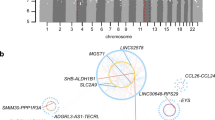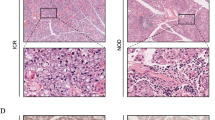Abstract
Objectives
Both type 1 and type 2 diabetes are accompanied by a high prevalence of hyposalivation (decreased salivary secretion), resulting in oral tissue damage. However, the molecular basis for the hyposalivation is yet unknown. Identifying genes and proteins that account for diabetes-related hyposalivation will help understanding the basis for this condition and identifying disease biomarkers in saliva.
Materials and methods
We integrated genomic data from 110 high-throughput studies with computational modeling, to explore the relationship between diabetes and salivary glands on a genomic scale.
Results
A significant overlap exists between genes that are altered in both types of diabetes and genes that are expressed in salivary glands; 87 type 1 diabetes and 34 type 2 diabetes associated genes are also common to salivary glands. However, the overlap between these genes is not significant.
Conclusions
Type 1 and type 2 diabetes associated genes are involved in the salivary secretion process, but mostly at different parts of it. This suggests that type 1 and type 2 diabetes impair salivary secretion by affecting different processes in the salivary tissue.
Clinical relevance
The genomic characteristics of Type 1 and type 2 diabetes may explain differences in salivary gland tissues morphology and saliva composition in people with diabetes, and suggest candidate proteins for diabetes salivary biomarkers.




Similar content being viewed by others
References
Chia JSJ, McRae JL, Cowan PJ, Dwyer KM (2012) The CD39-adenosinergic axis in the pathogenesis of immune and nonimmune diabetes. J Biomed Biotechnol 2012:320495
Castano LEG (1990) Type-I diabetes: a chronic autoimmune disease of human, mouse, and rat. Annu Rev Immunol 8:647–679
Seino Y, Nanjo K, Tajim N, Kadowaki T, Kashiwagi A, Araki E et al (2010) Report of the committee on the classification and diagnostic criteria of diabetes mellitus. J Diabetes Investig 1(5):212–228
K M P, Johnson P, Ganesh M, Subhashini AS (2013) Evaluation of salivary profile among adult type 2 diabetes mellitus patients in South India. J Clin Diagn Res 7(8):1592–1595
Busato IMS, Ignácio SA, Brancher JA, Grégio AMT, Machado MAN, Azevedo-Alanis LR (2009) Impact of xerostomia on the quality of life of adolescents with type 1 diabetes mellitus. Oral Surg Oral Med Oral Pathol Oral Radiol Endod. 108(3):376–382
Bakianian Vaziri P, Vahedi M, Mortazavi H, Abdollahzadeh S, Hajilooi M (2010) Evaluation of salivary glucose, IgA and flow rate in diabetic patients: a case-control study. J Dent (Tehran) 7(1):13–18
Moore PA, Guggenheimer J, Etzel KR, Weyant RJ, Orchard T (2001) Type 1 diabetes mellitus, xerostomia, and salivary flow rates. Oral Surg Oral Med Oral Pathol Oral Radiol Endod 92(3):281–291
Mathison RD, Davison JS, Befus AD, Gingerich DA (2010) Salivary gland derived peptides as a new class of anti-inflammatory agents: review of preclinical pharmacology of C-terminal peptides of SMR1 protein. J Inflamm (Lond) 7:49
Mednieks MI, Szczepanski A, Clark B, Hand AR (2009) Protein expression in salivary glands of rats with streptozotocin diabetes. Int J Exp Pathol 90(4):412–422
Lee MG, Ohana E, Park HW, Yang D, Muallem S (2012) Molecular mechanism of pancreatic and salivary gland fluid and HCOFormula secretion. Physiol Rev 92:39–74
Changrani NR, Chonkar A, Adeghate E, Singh J (2006) Effects of streptozotocin-induced type 1 diabetes mellitus on total protein concentrations and cation contents in the isolated pancreas, parotid, submandibular, and lacrimal glands of rats. Ann N Y Acad Sci 1084:503–519
Isola M, Lantini M, Solinas P, Diana M, Isola R, Loy F et al (2011) Diabetes affects statherin expression in human labial glands. Oral Dis 17(7):685–689
Sabino-Silva R, Alves-Wagner ABT, Burgi K, Okamoto MM, Alves AS, Lima GA et al (2010) SGLT1 protein expression in plasma membrane of acinar cells correlates with the sympathetic outflow to salivary glands in diabetic and hypertensive rats. Am J Physiol Endocrinol Metab 299(6):E1028–E1037
Caseiro A, Vitorino R, Barros AS, Ferreira R, Calheiros-Lobo MJ, Carvalho D et al (2012) Salivary peptidome in type 1 diabetes mellitus. Biomed Chromatogr 26(5):571–582
Verma M, Metgud R, Madhusudan A, Verma N, Saxena M, Soni A (2014) A comparative study of glutamate oxaloacetate transaminase (GOT) and glutamate pyruvate transaminase (GPT) levels in the saliva of diabetic and normal patients. Biotech Histochem 1–6
Satish BNVS, Srikala P, Maharudrappa B, Awanti SM, Kumar P, Hugar D (2014) Saliva: a tool in assessing glucose levels in diabetes mellitus. J Int oral Heal JIOH 6(2):114–117
Malathi L, Masthan KMK, Balachander N, Babu NA, Rajesh E (2013) Estimation of salivary amylase in diabetic patients and saliva as a diagnostic tool in early diabetic patients. J Clin Diagn Res 7(11):2634–2636
Lilliu MA, Solinas P, Cossu M, Puxeddu R, Loy F, Isola R, Quartu M, Melis T IM (2014) Diabetes causes morphological changes in human submandibular gland: a morphometric study. J Oral Pathol Med
Anderson LC, Suleiman AH, Garrett J (1994) Morphological effects of diabetes on the granular ducts and acini of the rat submandibular gland. Microsc Res Tech 27(1):61–70
Shikama Y, Ishimaru N, Kudo Y, Bando Y, Aki N, Hayashi Y et al (2013) Effects of free fatty acids on human salivary gland epithelial cells. J Dent Res 92(6):540–546
Bernardi MJ, Reis A, Loguercio AD, Kehrig R, Leite MFNJ (2007) Study of the buffering capacity, pH and salivary flow rate in type 2 well-controlled and poorly controlled diabetic patients. Oral Heal Prev Dent 5(1):73–78
Jancsik VA, Gelencser G, Maasz G, Schmidt J, Molnar GA, Wittmann I et al (2014) Salivary proteomic analysis of diabetic patients for possible oral squamous cell carcinoma biomarkers. Pathol Oncol Res 20(3):591–595
Piras M, Hand AR, Mednieks MI, Piludu M (2010) Amylase and cyclic amp receptor protein expression in human diabetic parotid glands. J Oral Pathol Med 39(9):715–721
Isola M, Cossu M, Diana M, Isola R, Loy F, Solinas P et al (2012) Diabetes reduces statherin in human parotid: immunogold study and comparison with submandibular gland. Oral Dis 18(4):360–364
Szczepanski A, Mednieks MI, Hand A (1998) Expression and distribution of parotid secretory proteins in experimental diabetes. Eur J Morphol 36:240–246
Wang D, Yuan Z, Inoue N, Cho G, Shono M, Ishikawa Y (2011) Abnormal subcellular localization of AQP5 and downregulated AQP5 protein in parotid glands of streptozotocin-induced diabetic rats. Biochim Biophys Acta. Elsevier B.V.; 1810(5):543–54
Jurysta C, Nicaise C, Giroix M-H, Cetik S, Malaisse WJ, Sener A (2013) Comparison of GLUT1, GLUT2, GLUT4 and SGLT1 mRNA expression in the salivary glands and six other organs of control, streptozotocin-induced and Goto-Kakizaki diabetic rats. Cell Physiol Biochem 31(1):37–43
Sabino-Silva R, Freitas HS, Lamers ML, Okamoto MM, Santos MF, Machado UF (2009) Na+−glucose cotransporter SGLT1 protein in salivary glands: potential involvement in the diabetes-induced decrease in salivary flow. J Membr Biol 228(2):63–69
Uhlén M, Fagerberg L, Hallström BM, Lindskog C, Oksvold P, Mardinoglu A, Sivertsson Å, Kampf C, Sjöstedt E, Asplund A, Olsson I, Edlund K, Lundberg E, Navani S, Szigyarto CA, Odeberg J, Djureinovic D, Takanen JO, Hober S, Alm T, Edqvist PH, Berling H, Teg PF (2015) Proteomics. Tissue-based map of the human proteome. Science (80- ). 347(6220):1260419
Huang da W, Sherman BT, Lempicki R (2009) Systematic and integrative analysis of large gene lists using DAVID bioinformatics resources. Nat Protoc 4(1):44–57
McKusick-Nathans Institute of Genetic Medicine, Johns Hopkins University (Baltimore M. Online Mendelian Inheritance in Man, OMIM®. 2015
Wang Y, Thilmony R, Gu YQ (2014) NetVenn: an integrated network analysis web platform for gene lists. Nucleic Acids Res 42(Web Server issue):W161–W166
Dang MN, Mary Q (2013) Epigenetics in autoimmune diseases with focus on type 1 diabetes. (November 2012):8–18
Saino T, Watson EL (2009) Inhibition of serine/threonine phosphatase enhances arachidonic acid-induced [Ca2+]i via protein kinase A. Am J Physiol Cell Physiol 296:C88–C96
Holman RT, Johnson SB, Gerrard JM, Mauer SM, Kupcho-Sandberg S, Brown DM (1983) Arachidonic acid deficiency in streptozotocin-induced diabetes. Proc Natl Acad Sci U S A 80(April):2375–2379
Morris PA, Prout RES, Proctor GB, Garrett JR, Anderson LC (1992) Lipid analysis of the major salivary glands in streptozotocin-diabetic rats and the effects of insulin treatment. Arch Oral Biol 37(6):489–494
Groop L, Pociot F (2014) Genetics of diabetes—are we missing the genes or the disease? Mol Cell Endocrinol 382(1):726–739
Uruska A, Araszkiewicz A, Zozulinska-Ziolkiewicz D, Wegner M, Grzelka AW-WB (2014) Does serum cystatin C level reflect insulin resistance in patients with type 1 diabetes? Clin Biochem 47(13–14):1235–1238
Author information
Authors and Affiliations
Corresponding author
Ethics declarations
Conflict of interest
The authors declare that they have no conflict of interest.
Funding
The work was supported by the Goodman Faculty of the Bar Ilan University, Ramat- Gan, Israel.
Ethical approval
This article does not contain any studies with human participants or animals performed by any of the authors.
Rights and permissions
About this article
Cite this article
Tickotsky, N., Ofran, Y. Integrating genomic data from high-throughput studies with computational modeling reveals differences in the molecular basis of hyposalivation between type 1 and type 2 diabetes. Clin Oral Invest 22, 151–159 (2018). https://doi.org/10.1007/s00784-017-2094-2
Received:
Accepted:
Published:
Issue Date:
DOI: https://doi.org/10.1007/s00784-017-2094-2




